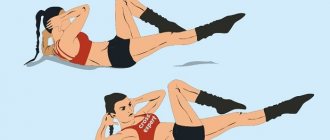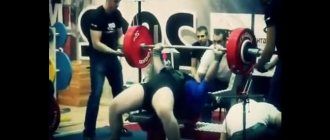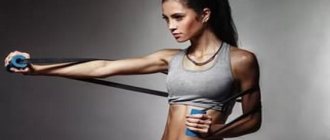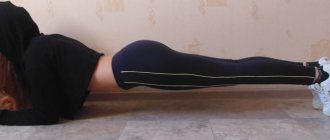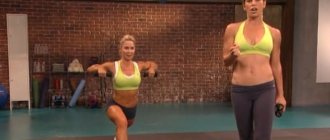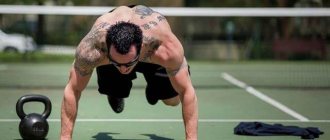The climbing exercise has spread to different fitness areas from CrossFit. Its second name is climber, by analogy with the movements performed. Used in workouts aimed at burning subcutaneous fat and working out muscles in the lower body. Here you will find a detailed description of the exercise in classical and variable techniques, its advantages and disadvantages. Find out what to pay attention to when performing it, how to use it in training complexes.
Performed at an accelerated pace, using large muscles in the lower body. Thanks to this, the respiratory and cardiovascular systems are stressed, which helps build endurance and also reduces the likelihood of heart and vascular diseases.
Which muscles work more actively than others and take on the main load:
- abdominal Press;
- thighs and buttocks;
- shins.
When lying down with straightened arms, the back and triceps receive a noticeable load. With regular practice, all tendons and ligaments are strengthened. In the climber's step variation, more stress is placed on the buttocks and quadriceps, due to this, energy consumption increases, which is beneficial when getting rid of extra pounds.
Quick execution promotes weight loss and cutting, as this speeds up metabolic processes.
About the benefits
Its versatility allows it to be included in a wide variety of complexes, for example, to complement deadlifts and other weightlifting workouts or to do between squats. You can start it almost immediately, without any special warm-up, since in itself it provides a warm-up effect.
Other benefits:
- quick toning of the muscular and nervous system before performing heavier elements;
- combining the benefits of planks and cardio exercises. The upper part of the body is static, this is stabilization training, the lower part works in dynamics, which increases calorie consumption and accelerates fat burning;
- improved coordination and sense of balance, this will be useful for those who run and play active team games. The skill allows you to abruptly change the trajectory of movement while maintaining balance, this saves time;
- adding a metabolic element;
- efficiency in working out the abdominal muscles, unlike most exercises, is affected from different angles, due to which both the rectus and oblique muscles are simultaneously included in the work. This is how the abs work during everyday activity. Compared to others, it wins in functionality;
- saving time on cardio, becomes an interval element, reducing the duration of the aerobic part without losing efficiency;
- the ability to combine abdominal training with strengthening other muscle groups; instead of several different techniques, one is performed, and the result remains the same;
- can be used at home and in group women's programs as a strength part.
About the disadvantages
With all the advantages, there are also disadvantages. First of all, it cannot be used to build muscle mass. Performed under the burden of your own weight, this is an insufficient stimulus for growth. Designed to develop endurance and strengthening, but not hypertrophy.
To get the benefits, you will need to study in detail how to do the climbing exercise correctly and learn to feel the work of your muscles. If done incorrectly, there will be no sense. For example, if you do not control the use of the press, it will be performed only by lifting the pelvis and moving the legs.
The disadvantages include a considerable number of contraindications:
- cardiovascular dysfunctions;
- recent surgical interventions;
- rehabilitation after injuries to knees, ankles, shoulders, elbows;
- diastasis with risk of re-divergence;
- protrusions and hernias, accompanied by pain;
- high blood pressure and predisposition to it;
- pregnancy.
What muscles work?
The climbing exercise works many muscle groups. Its main advantage is its versatility, as it is suitable for both men and women. It will be an ideal start for obese people, because it combines multi-joint and aerobic characteristics. For the complete anatomy of the exercise, see the table below.
As you can see from the table, this exercise uses almost all the muscles on the human body. By using special rubber bands, you can significantly increase the emphasis on the abdominal muscles or leg muscles. Unfortunately, due to the inability to evenly distribute the increased load across the entire body, the climber ended up on the list of aerobic exercises.
Technical recommendations
You can move on to the most interesting options only after you have mastered the classic one perfectly. Many are intended only for athletes with excellent training; inexperienced people cannot do them.
Classic version:
- take the starting position of the plank;
- tighten your core muscles, it is especially important to feel the tension in the abdominal area;
- sharply bend one knee and pull it towards the chest without touching the ground;
- return to the original position in the same way;
- repeat immediately to others.
Mandatory rules for the exercise of a climber in a prone position:
- movement without pauses so that it looks like jogging while lying down;
- make sure that your back does not round or sag in the lower back;
- arms do not bend;
- the head is slightly lowered so that there is no excessive tension in the neck;
- the upper body is fixed, only the lower limbs change their position;
- the faster you do it, the higher the efficiency;
- how much to do depends on preparation. The minimum duration for beginners is 15 seconds, then this period should be extended to a minute.
This variation is aimed at increasing tone and accelerating weight loss. As a general tonic, it is suitable for children and people in poor shape. It will not be possible to monitor correctness through a mirror, since the gaze must be lowered. Therefore, it is necessary to ask someone to monitor it from the outside or record it on video, then view and analyze the errors.
If you want most of the tension to go to the press, then do the same, but slowly: pull your knees not sharply, but smoothly. With this design, you will have to monitor the stability of the case so that it does not sway. The body is represented by a line from the heels to the crown. With the slow version, you don’t need to time it; it’s more objective to count the repetitions. The optimal volume is four sets of 15 repetitions.
Other recommendations:
- The arms should be constantly straightened for stability, as well as to shift the emphasis to the abs. If you do it on the elbows, then the biceps and triceps will take on part of it; the abs will not receive enough tension until fatigue, which will come faster. The fact is that the press is very hardy; in order to give it enough work, you will have to try;
- The head should not be thrown back or lowered so that the chin approaches the chest. If you do not follow this, the neck and trapezius will be under tension, which will lead to pain in them after exercise. You shouldn't look left and right for the same reason;
- You cannot relax your back, as this will cause your chest to begin to sag towards the floor. This creates a danger for the shoulders and aggravates lumbar lordosis;
- performed sharply, but not by jumping. Despite the high tempo, actions must be rhythmic and uniform;
- don’t just move your hip forward and send it back, but strongly strain your abs and bring your pelvis to the bottom of your chest;
- the knee moves forward as you exhale, and back as you inhale, this ensures correct distribution of work;
- The pelvis should not go up, so it is important to ensure that the hip joint does not bend.
How to improve efficiency?
Having learned what a climbing exercise is and having mastered the technique, you can move on. It doesn't hurt to know how many calories it burns and how to improve its efficiency. Energy expenditure depends on intensity and body weight. On average, a 55kg person will burn 450 calories per hour of continuous exercise. Complicated versions are more energy-intensive.
The lesson can be started directly from the climber; no preliminary warm-up is required. You can simply take a lying position and start performing the classic variation, this will be preparation for more difficult exercises. However, if you do a light cardio workout at the beginning, your efficiency and energy expenditure will increase. A good addition would be joint exercises, especially for the wrists and shoulders, since they will be inactive during the exercise.
Other recommendations:
- If it is difficult to maintain balance, then you need to work on it first. A preparatory technique will be a plank on straight arms; it will teach you to maintain balance without shifting in different directions;
- The shoulders and neck should be considered as a single whole, since their correct positioning is interdependent. The neck should stretch, while the shoulders drop;
- To lose weight you need to do it quickly. The pace does not affect the quality of the work, but creates a metabolic effect, accelerating metabolic processes;
- if you need to work the oblique abdominal muscles, then you should move your leg diagonally, first a little to the side, then to the chest. In order for the lateral climber to provide more work to the transverse muscle, the abdomen should be drawn in more.
Exercise rock climber
The “climbing” exercise for the abs is an extremely effective cardio exercise that helps strengthen the cardiovascular system and increases the overall endurance of the body.
With its help, if performed correctly, an athlete can get strong and aesthetically pleasing abs in a relatively short time. The basis of the exercise is the “plank” position, which engages the deep muscles and forces them to work with maximum efficiency. No additional equipment or sports equipment is required for classes.
Many athletes choose this exercise as a warm-up, as it allows them to quickly warm up their muscles and prepare for subsequent workouts.
How to diversify your workout?
If the task is to load not the muscles of the abdominal region, but the legs, then it is worth turning the climber into a technique called a floor polisher. To do this, you will need to place a small towel under your feet and slide them along the floor without lifting your socks off the floor. To increase the overall level of gravity, you should rest your forearms on a bosu hemisphere or other unstable platform. It will take more effort to maintain balance.
Another way to diversify your training is to fix your feet in TRX loops; with them everything will happen faster and you will burn more calories. You can also use a fitness band; if you fasten it in the knee area, the work of your hips will become more intense. By itself, the climber is more effective than crunches, but if you use them in combination, the work will be deeper. It is worth paying attention to the most effective variations.
trx1.jpg" alt="girl training" width="100%" height="563″>
With weights
After the technique is mastered, you can complicate the task by connecting weighted cuffs. It’s worth starting with the lightest ones, weighing no more than 500 grams. If you immediately connect a lot of weight, the equipment will suffer and efficiency will become lower. The cuffs are worn on the shins and can be used for any variation.
Jumping
This is a lightweight version, suitable for those who find the classic version too heavy. Since the technique involves jumping, it is necessary to stretch the joints of the lower extremities before proceeding:
- Take a lying position with support on your toes and straight arms.
- Tighten the muscles of the abdomen and buttocks.
- Push off with one toe from the floor, move it under your chest with a slight jumping movement and place it on the floor.
- With the same light jump, return the toe to the starting position and do the same with the other leg.
- Performed continuously in 3-4 sets of 12-15 repetitions.
With a twist
Rotations of the body increase the tension of the oblique muscles, increase the amplitude and mobility of the hip joint and stretch the gluteal muscles.
- Stand in a plank position, straighten your shoulders, pull your stomach in.
- As you exhale, bend your right knee and pull it towards your left elbow, twisting your body.
- Inhale and return to plank.
- Immediately repeat the action with the other leg.
- It is important to control that the pelvis does not sag towards the floor. Performed at an average pace in 3-4 approaches of 12-15 times.
Bipedal
It is done very quickly, which allows you to spend more calories and speed up the burning of subcutaneous fat. The emphasis is on the rectus abdominis muscle.
- Stand upright lying down so that your body becomes a single line.
- With a sharp movement, pull both knees to your chest at once, this is done while exhaling.
- As you inhale, return the feet to their place in reverse.
- It is necessary to ensure that the pelvic area does not sink to the floor. The approach should contain at least 25-30 repetitions.
On fitball
To reduce pressure on the shoulder girdle, you can perform it by resting your palms on a fitball. With this variation, small stabilizer muscles will be trained; they are responsible for maintaining balance.
- Place your palms on the ball and move your legs back.
- Fully straighten your elbows, adjust the tilt of your body so that the angle with respect to the floor is about 40 degrees.
- As you exhale, bend one knee and touch it to the fitball, and while inhaling, bring it back.
- Immediately repeat the second.
The back should not be rounded. At least three repetitions of 12 times are required. If it is difficult to maintain balance, you can start training against a wall so that the fitball cannot roll away.
Sumo technique with jumps
This is a plyometric version aimed at accelerating the burning of body fat. An additional impact is the development of explosive strength in the lower extremities.
- Get into a plank position.
- With a powerful jerk, push off the floor with both toes and make a jumping movement with them towards the hands so that each foot stands next to the palm on the outside. At this point, the body will assume a deep sumo squat position.
- Jump back to the plank and do at least 15 repetitions without pauses.
- The palms should remain firmly pressed to the surface.
With half-bent arms
This variation increases tension in the shoulder girdle. The difference from the classic variation is that in the plank you should bend your elbows to approximately a right angle.
How to include in training?
By doing rock climbing, you can burn 8 to 15 calories every minute, which is decent, but not enough for weight loss. Therefore, a balanced training program is necessary. The following is an example of a plan for girls, it is aimed at getting rid of subcutaneous fat and improving the tone of the lower body:
- running on a treadmill or jumping rope - 5-7 minutes;
- plyometric squats with jump - 3 x 20 times;
- lunges with weights - 3 x 15 times;
- crossover leg abductions - 3 x 15 repetitions;
- climber - 3 x 30 seconds;
- jogging at a measured pace - 10 minutes.
The male body is designed differently, so they require different loads. Performed after aerobic warm-up, all techniques in three approaches 15 times:
- air squats;
- leg press in the simulator;
- lunges with weights;
- leg extension while sitting in a machine;
- climber with weights on ankles;
- crunches on a Roman bench.
The climbing exercise is recommended for use in functional split training.
Execution options
Beginners can start with exercises where the hands are elevated rather than on the floor. They can also perform the exercise with a shorter range of motion so that the knees do not reach the chest.
In order to remember the sequence of movements in exercises that require alternate performance with different legs, you can do repetitions first with one leg, then with the other. You need to start the exercises slowly, then gradually increase the speed.
How to perform the “Climbers” exercise correctly? The photos show in detail all stages of the exercises.
